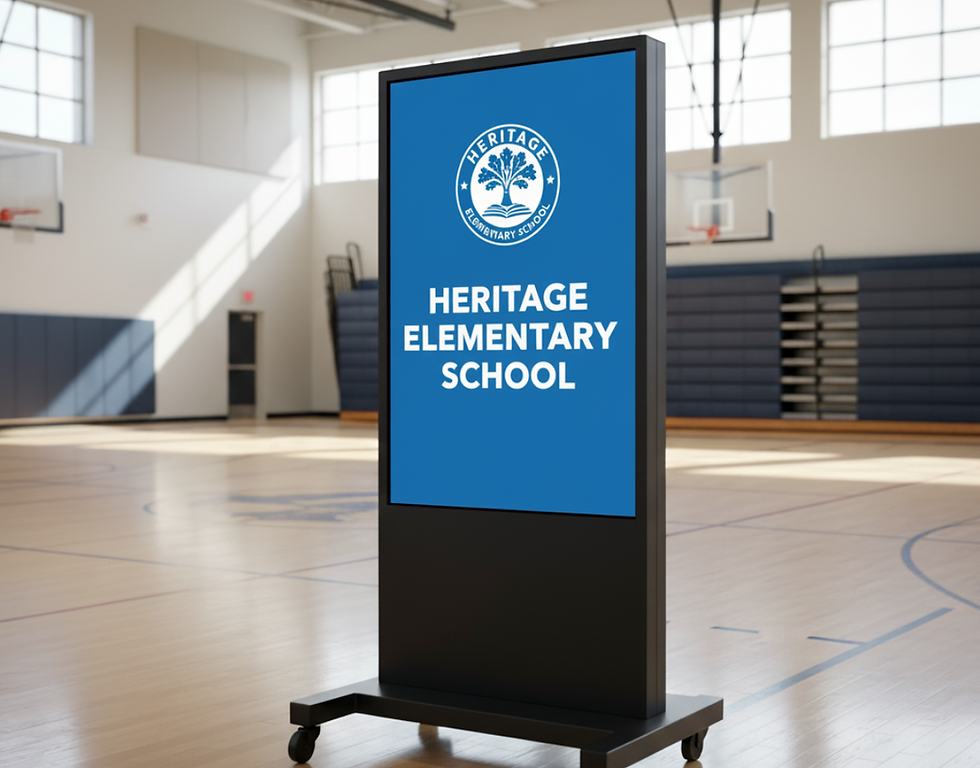Inspiring Learning: Branded Educational Items for Student Giveaways
- alonzo alaniz

- 6 days ago
- 7 min read

At Platinum Consulting Services (PCS), we have seen how the right tools and thoughtful branding can transform learning moments into lasting connections.
Branded educational items for student giveaways serve as meaningful extensions of your school’s identity. They’re small, purposeful touchpoints that build pride, encourage participation, and keep your mission visible every day.
In this guide, PCS shares how to choose meaningful items, design them effectively, and plan a giveaway strategy that drives real learning and community connection.
Why Branded Educational Items Work For Student Giveaways
Branded educational items for student giveaways work because they live where learning happens, on desks, in backpacks, and on devices. Useful items have lasting visibility, and students tend to remember the brand behind them. That kind of daily exposure helps build familiarity and trust over time.
Giveaways also create a genuine emotional lift. When students receive something practical and well-designed, they feel valued and included. That sense of appreciation carries into classrooms and school events, boosting participation and school spirit.
The impact doesn’t stop there. As students use branded gear around campus or share it on social media, your school identity spreads naturally, creating a community presence that draws in parents, alumni, and partners alike. According to PPAI research, students are more likely to remember a school or organization that gives them a useful branded item, proof that thoughtful giveaways can leave a lasting impression.
How To Choose The Right Items

Audience, Age, And Setting Fit
Start with who you’re serving and where items will be used. For K–12 students, backpacks, water bottles, and notebooks travel easily between home and school. College students often prefer tech accessories like USB drives, stylus pens, and earbuds. For arts or CTE programs, sketchbooks and durable tool pouches fit daily needs.
PCS helps schools match items to age, subject, and setting so every giveaway connects with real learning moments.
Educational Value, Utility, and Durability
Choose items students will actually use—like notebooks, pens, folders, planners, and highlighters. Everyday tools mean daily visibility. Prioritize quality: sturdy bindings, reinforced stitching, and spill-resistant finishes help items last all year.
PCS sources classroom-grade materials built to last through an entire academic term. Learn more about PCS products.
Inclusivity, Accessibility, And Safety
Pick items that work for everyone. Ambidextrous scissors, left or right-hand-friendly notebooks, and easy-grip pens remove small but meaningful barriers. Choose allergen-aware materials and verify that all wearables meet safety standards for the right age group.
Sustainability And Material Choices
Sustainability is no longer optional, it’s expected. Recycled paper notebooks, bamboo pens, BPA-free bottles, and reusable totes align with modern eco goals. Learn more about sustainable materials and safe classroom product standards from the U.S. Environmental Protection Agency (EPA)
Best Giveaway Ideas By Category

Classroom Essentials
Start with the basics: lined notebooks, composition books, folders, and pencils. Pair notebooks with adhesive tabs so students can organize notes and projects easily. A simple “first-week kit” (notebook, folder, pencil, and eraser) sets a positive, ready-to-learn tone from day one.
Study Aids And Organization
Planners, sticky notes, index cards, and page flags help students stay organized. Add a semester overview or QR code linking to study tips for extra value. Small touches like pen loops or bookmark ribbons make tools more convenient and encourage daily use.
Tech Accessories For Learning
Stylus pens, USB drives, cable organizers, webcam covers, and earbuds are essentials for digital and remote learning. You can also include screen-cleaning cloths with your logo for a simple, practical item that gets constant use.
Wellness And Safety Items
Refillable water bottles, hand sanitizers, and compact first-aid kits show care for student wellbeing. For athletics and outdoor programs, items like cooling towels or SPF stick sleeve are great additions students actually use.
Eco-Friendly Options
Recycled totes, bamboo pens, and metal straws show environmental commitment. Students are more likely to keep items that feel sustainable and high-quality.
Event-Ready Kits And Bundles
For orientations, STEM nights, or career fairs, themed bundles make distribution easy and cohesive. Try a “Study Start Kit” (notebook, folder, pencil, eraser), a “Maker Kit” (ruler, markers, safety glasses), or a “Hybrid Learning Kit” (earbuds, stylus, cable wrap). Bundles are easy to distribute and create a cohesive experience for students.
Design And Branding Tips For Maximum Impact

Logo Placement And Legibility
Keep logos simple and visible. Front center on notebooks, upper third on bottles, and clip area on pens. Avoid cluttered designs. Clean, high-contrast logos are easier to read and look more professional.
Messaging That Adds Educational Value
Combine branding with purpose. Add motivational lines, school values, or QR codes linking to learning resources. These small details turn giveaways into teaching tools.
Color, Finish, And School Spirit Alignment
Match school colors and mascot designs. Matte finishes often look more premium and reduce glare, improving readability. If sponsors are involved, keep your school’s identity the main focus while using complementary colors for partners.
Co-Branding And Sponsor Recognition
When partnering with sponsors, maintain a clear visual hierarchy school first, sponsor second. Place partner logos on the back or secondary imprint areas. This approach preserves design balance and pride in your school brand.
Budgeting, Quantities, And Logistics
Cost Tiers And Prioritizing ROI
Stretch budgets by mixing item tiers. Use affordable, high-frequency items for wide distribution, and reserve premium pieces for special programs or recognition. Focus on items used daily—they deliver the highest return.
Order Timelines And Proofing
Plan backward from your event date. Build in buffer time for design approval, production, and shipping—especially during back-to-school season. Always review digital proofs and request samples for color accuracy.
Distribution Strategies That Drive Engagement
Reach students where they already are at orientations, open houses, and club fairs. Add excitement with social media reveals, giveaways, or simple classroom challenges. For remote learners, include lightweight, mail-friendly items and make the unboxing moment part of the fun.
Compliance, Safety, And Legal Considerations
Always confirm that products meet age-appropriate safety and district procurement standards. Verify BPA-free materials and ensure mascot or slogan use follows trademark rules. For guidance on labeling and endorsement standards, see the FTC’s compliance guide.
Measuring Success And Iterating
Simple Metrics To Track Impact
Track how items are used after distribution. Check if students still use them a month later, monitor social media mentions, and review QR code data or page visits. Send quick surveys to gather feedback on what worked best.
Feedback Loops With Students And Staff
Ask teachers which items appear most in class and invite students to vote on next year’s designs. This collaboration turns giveaways into a shared project and keeps engagement high. For more ideas on engaging students through design and feedback, visit classroom engagement resources.
Post-Event Engagement And Reuse
Keep momentum going with light challenges like planner check-ins, hydration streaks, or screen-cleaning days. Offer small incentives or shout-outs to encourage continued use. These help keep your brand visible and valued all year long.
Conclusion

Branded educational items for student giveaways do more than look good. They make an impact where it matters most: during note-taking, study sessions, and school events. When schools choose durable, inclusive, and well-designed items and plan distribution thoughtfully, they strengthen engagement and school identity at every level.
At Platinum Consulting Services (PCS), we combine smart promotional products with innovative educational technology solutions to support modern learning. Explore our promotional catalog to see what’s possible, or let us create a custom plan tailored to your school’s goals and budget.
Looking to upgrade your classrooms? Contact PCS for a personalized tech plan. You can also request a free demo or quote to explore how our solutions bring smarter teaching tools to life.
Learn more about who we serve or visit the PCS Blog for more ideas on building engagement and strengthening your school’s brand.
Frequently Asked Questions
What are branded educational items for student giveaways, and why do they work?
Branded educational items for student giveaways are practical tools such as notebooks, pens, and tech accessories that carry your school’s identity. They work because students use them where learning happens, increasing daily visibility and fostering positive emotions and school pride. Consistent, useful items help students remember your brand and naturally extend your presence across classrooms and events.
How do I choose the right student giveaway items by age and setting?
Start by matching the items to the students who will use them and the environment they’ll be in. K–12 students benefit from durable notebooks, folders, water bottles, and simple study aids. College students often prefer tech accessories like stylus pens, earbuds, USB drives, and cable organizers. Focus on utility, durability, inclusivity, safety, and sustainability to ensure long-term use and value.
What are affordable options that still make an impact?
Go for versatile, useful items like folders, planners, pencils, or sticky notes. Add small custom touches QR study links or color-matched designs to increase reuse and visibility without adding cost.
How should I design and place logos effectively?
Keep designs clean and readable. Place your logo where it’s naturally visible front and center on notebooks, near the top on bottles, or along the clip area of pens. Use high contrast and minimal clutter for a polished, professional look. Pair your branding with value by adding short study reminders, motivational quotes, or QR links to school resources. Keep sponsor logos secondary, so your school’s identity remains the main focus.
How much should I budget per student for branded educational items?
A good guideline is $1–$3 per student for common items like pens or notebooks, $3–$7 for mid-range pieces like planners or stainless bottles, and $8–$20 for premium or bundled kits. Prices vary by material, print colors, and quantity. Combine different price tiers by distributing basic items broadly while reserving premium ones for special recognition or achievement.
Are QR codes on student giveaways compliant with student privacy rules?
Yes, when used responsibly. Link QR codes to public resources or learning platforms that don’t collect personal data. Avoid tracking minors without verified consent, and follow FERPA and COPPA guidelines. Use anonymized analytics, clear explanations, and short institutional URLs to maintain transparency and student safety.





Comments